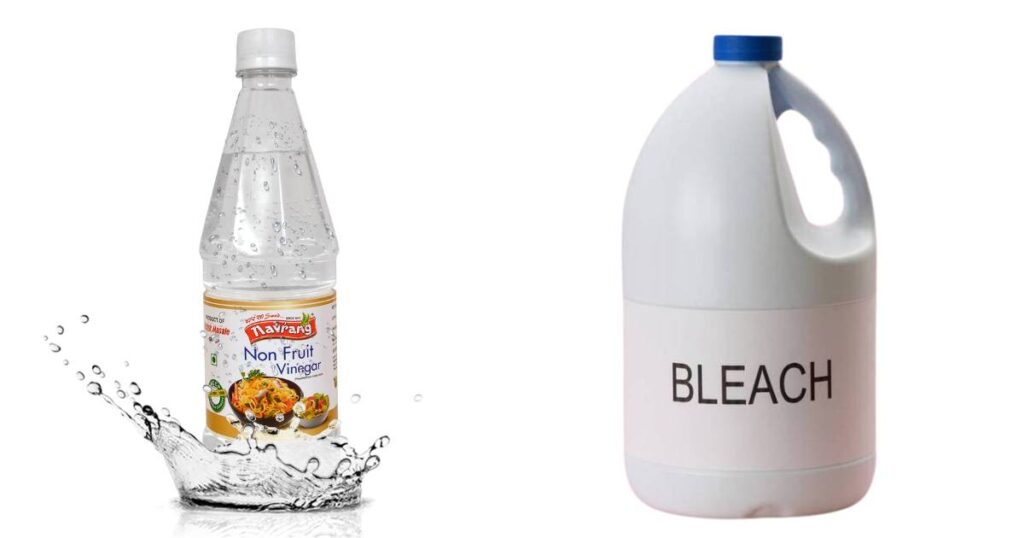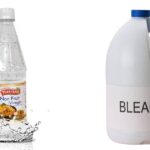You know how we all love a good deep clean, right? But one combo you gotta avoid? Mixing bleach and vinegar – it’s a recipe for danger. These two household cleaners seem harmless alone, but together they create a toxic chlorine gas that’s no joke.
We’re talking burning eyes, coughing fits, breathing issues – not the refreshing clean you want. Chlorine gas can actually be life-threatening if you inhale too much. So do yourself a favor and keep bleach and vinegar far apart.
There are plenty of safer, green cleaning alternatives that’ll get your home spotless without the health risks. For now, remember: bleach plus vinegar equals hard pass!
Can You Mix Bleach and Vinegar?
Absolutely not! Mixing bleach, which contains sodium hypochlorite, and vinegar, a diluted form of acetic acid, triggers a dangerous chemical reaction that produces chlorine gas. This toxic gas is extremely hazardous and can have severe, potentially life-threatening consequences if inhaled or exposed to in high concentrations.
While bleach and vinegar are both effective cleaning agents when used separately, their combination creates a volatile mixture that should be avoided at all costs. The chlorine gas released by this reaction can cause a range of symptoms, from minor irritation to severe respiratory distress, depending on the level of exposure.
To ensure the safety of yourself and your loved ones, it’s crucial to never mix these two common household products. Always read labels carefully and follow the manufacturer’s instructions to the letter when using any cleaning solutions.
Symptoms of Bleach and Vinegar Reaction Exposure

If you’ve accidentally mixed bleach and vinegar or been exposed to the resulting chlorine gas, it’s essential to be aware of the potential symptoms and seek immediate medical attention if necessary.
The severity of the symptoms can vary depending on the concentration of the gas and the duration of exposure, but some common signs to watch out for include:
- Blurred or impaired vision
- Burning sensation in the nose, throat, or eyes
- Persistent coughing and chest tightness
- Difficulty breathing or shortness of breath
- Fluid buildup in the lungs (pulmonary edema)
- Nausea and vomiting
Prolonged exposure to high levels of chlorine gas can lead to more severe complications, such as respiratory failure or chemical pneumonitis.
If you experience any of these symptoms, it’s crucial to seek immediate medical attention and inform the healthcare professionals about the potential exposure to chlorine gas.
What to Do After Mixing Vinegar and Bleach?
In the unfortunate event that you’ve accidentally mixed bleach and vinegar and been exposed to chlorine gas, it’s essential to act quickly to minimize the potential harm. Follow these steps to ensure your safety:
- If the exposure occurred indoors, immediately open all nearby windows and doors to allow for proper ventilation. If possible, evacuate the area and call the American Association of Poison Control Centers at 1-800-222-1222 for further guidance.
- Carefully remove any contaminated clothing, taking care not to pull it over your head or face, as this could increase your exposure to the chlorine gas.
- If your eyes are burning or irritated, rinse them thoroughly with lukewarm water for 10 to 15 minutes. Avoid using eye drops, as they may exacerbate the irritation.
- Take a lukewarm shower, using mild soap to gently wash your skin from head to toe. Be cautious not to let the water enter your eyes, mouth, or nose during this process.
- Seek medical attention immediately, even if your symptoms seem mild, as chlorine gas exposure can have delayed effects and potentially lead to more severe complications.
By following these steps promptly, you can minimize the risk of further harm and ensure that any necessary medical treatment is provided as soon as possible.
Alternatives to Bleach and Vinegar
While bleach and vinegar are popular cleaning agents, their potential for creating a hazardous situation when mixed calls for the exploration of safer alternatives.
Fortunately, there are numerous eco-friendly and effective options available that can help you maintain a clean and hygienic home without compromising your safety.
For Cleaning and Disinfecting
- Vinegar: Plain white vinegar is a versatile and natural disinfectant that can be used for a variety of cleaning tasks. It’s effective against viruses, mold, and bacteria, making it an excellent choice for disinfecting surfaces, brightening laundry, and removing soap scum and hard water stains.
- Baking Soda: This pantry staple is a gentle yet powerful cleaning agent that can tackle tough stains on clothing, furniture, and floors. Its abrasive properties make it ideal for scrubbing and whitening, while its mild nature ensures it’s safe for most surfaces.
- Hydrogen Peroxide: A 3% solution of hydrogen peroxide can effectively disinfect surfaces, including kitchen areas, without the harshness of bleach. It’s effective against a wide range of bacteria, mold, and odors, making it a versatile choice for various cleaning tasks.
- Lemon Juice: The citric acid found in lemon juice is a natural cleaning powerhouse. Mix it with hot water to create a potent solution for combating mold, mildew, and tough stains. The acidity helps break down grime and dirt, making it easier to scrub away.
- Multi-surface Cleaner Refills: Brands like Fomin offer eco-friendly, cruelty-free multi-surface cleaner refills made with non-toxic ingredients. These refills are designed to effectively clean various surfaces, including kitchen shelves, furniture, and tiles, without compromising your health or the environment.
For Laundry
- Oxygen Bleach: As a gentler and non-toxic alternative to chlorine bleach, oxygen bleach is an excellent choice for cleaning laundry and surfaces. It contains sodium percarbonate, which breaks down stains and brightens fabrics without damaging them.
- Salt: Regular table salt can be a surprisingly effective laundry aid. When mixed with water, it can help brighten fabrics and remove stubborn stains. Salt can also be used as a pre-treatment for tough stains or to tackle mildew in bathrooms.
By incorporating these safer alternatives into your cleaning routine, you can maintain a spotless and hygienic home without risking your health or the environment.
How does Fomin contribute to a greener and plastic-free world?
Fomin is a brand that is deeply committed to environmental sustainability and reducing plastic waste. With each purchase from Fomin, you actively contribute to saving 12 plastic bottles from destroying ocean life and damaging the delicate marine ecosystem.
Understanding the urgency of addressing environmental challenges, Fomin has incorporated sustainability into the very core of its brand philosophy.
By choosing Fomin’s products, you are not only ensuring a safer and healthier cleaning experience for your home but also playing a crucial role in creating a cleaner, greener planet.
Additionally, Fomin takes pride in being a carbon-neutral company, meticulously measuring and offsetting its carbon footprint to minimize its environmental impact.
FAQ’s
Can You Mix Vinegar and Bleach?
No, you should never mix vinegar and bleach. This combination creates a dangerous chemical reaction that releases toxic chlorine gas, which can cause severe respiratory issues and even be life-threatening in high concentrations.
What are the symptoms of chlorine gas exposure?
Common symptoms of chlorine gas exposure include blurred vision, burning sensations in the nose, throat, or eyes, persistent coughing, difficulty breathing, fluid buildup in the lungs, nausea, and vomiting.
Seek immediate medical attention if you experience these symptoms after accidental exposure.
How do I safely clean after mixing bleach and vinegar?
If you’ve accidentally mixed bleach and vinegar, immediately open windows for ventilation, remove contaminated clothing, rinse your eyes with lukewarm water, and take a lukewarm shower without letting water enter your eyes, mouth, or nose. Seek medical attention, even if symptoms seem mild.
Can I use vinegar for cleaning and disinfecting?
Yes, plain white vinegar is an effective and natural disinfectant that can be used for cleaning and disinfecting various surfaces, brightening laundry, and removing soap scum and hard water stains.
What are some safe alternatives to bleach for laundry?
Safer alternatives for laundry include oxygen bleach, which contains sodium percarbonate and is gentler on fabrics, and regular table salt, which can help brighten clothes and remove stains when mixed with water.
Also Read This Post:
20 FASHION TIPS TO DRESS BETTER IN 2024
Final Thoughts
In summary, mixing bleach and vinegar is an absolute no-go due to the formation of toxic chlorine gas, which can have severe and potentially life-threatening consequences.
By understanding the risks and being proactive in avoiding this dangerous combination, you can prioritize the safety of your family while maintaining a clean and hygienic living environment.
Embrace the numerous eco-friendly and safe alternatives available, such as vinegar, baking soda, hydrogen peroxide, and lemon juice, which can effectively clean and disinfect without compromising your health or the environment.
Remember, a little knowledge and caution can go a long way in ensuring a spotless home and a sustainable future.








